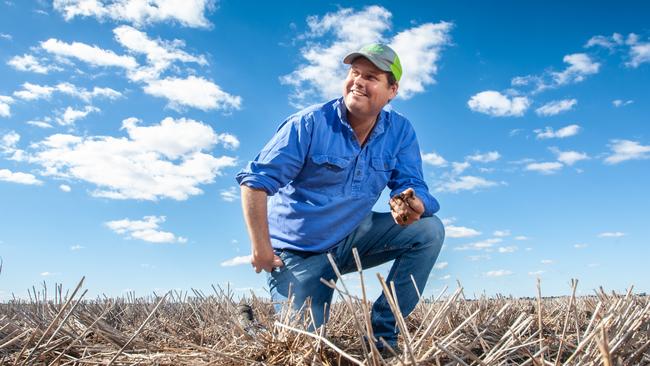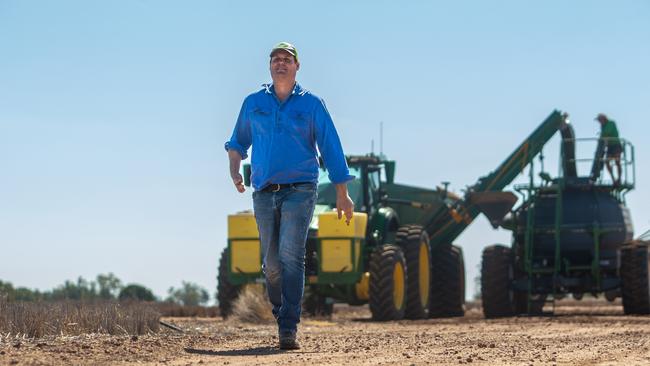How one farmer plans grow carbon credits under his crops
Nigel Corish is one of the first cropping farmers in Australia to develop a soil carbon project. See how he is preparing for the challenge.

Nigel Corish is at the forefront of the grain industry’s push towards sustainability.
For years, the Condamine crop grower has been working to retain moisture, improve the health of his soils and reduce his reliance on synthetic fertilisers, while improving the productivity of dryland wheat, barley, chickpeas, sorghum and irrigated cotton.
Now, he is one of the first cropping farmers in Australia to develop a soil carbon project.
He is taking what he calls a “leap of faith” into an industry many crop growers view with cynicism to understand whether farming carbon is possible on an Australian cropping property.

A decade ago, the question that set Nigel off on what was to become a lifetime commitment to improving farm sustainability, was how to improve nitrogen efficiency in cotton farming.
Every year, his business was investing hundreds of thousands of dollars on synthetic fertilisers, which were spread across his 4000ha property ahead of summer and winter crop planting.
He was closely watching international efforts to place caps on fertiliser use, and a brewing debate about how energy-intensive they are to produce, and the damage they cause to ecosystems if they are washed into waterways.
“I realised that we were starting to get some public pressure, plus government pressure, on the use of nitrogen around the world and it was pretty obvious to me that, at a point in time in the future, we would be restricted on the amount of nitrogen, or fertiliser, we could apply to our crops,” Nigel said.
Today, rules to reduce nitrogen application have been introduced in the Netherlands, New Zealand and are being discussed across Asia. No similar legislation has yet been proposed in Australia.
Through a Nuffield scholarship, he was funded to visit farms in North America, Europe and Asia to look for answers.
He came home in 2014 with ideas on how to improve the rate, timing, and application of nitrogen using new technology, and put those ideas to work on his farm.
Over time, he saw results. He was able to improve cotton yields from a long-term average of 13 to 14 bales per hectare to 15 bales per hectare in his harvest last month, with a urea application rate of between 500kg and 600kg/ha.
For his dryland crops, he started carting cattle manure back to the property from a nearby feedlot, and found that organic fertilisers, applied at a rate of 10 tonnes/ha once every five years or so, used in a rotation that includes nitrogen-fixing chickpeas, and combined with the ability to apply variable rates of fertiliser using precision technology, dramatically reduced his reliance on synthetic nitrogen.
An average application of 200kg/ha three years ago, fell to 80kg/ha last year and 120kg/ha this year.

RETAINING MOISTURE
For Nigel, cropping on the Western Darling Downs presents a series of challenges that can be overcome with careful trials, reflection, and an openness to changing his approach as his understanding grows.
Sustainability for him is not just a matter of reducing inputs, but also increasing what he is able to produce using limited resources.
One of the biggest limitations on the property is rainfall, which averages 550-600mm in a year and can be quickly lost in the dry climate.
Over the past decade, he has introduced two new techniques to increase the amount of water captured and stored in his soil. He credits them with boosting average cereal yields by 1 tonne/ha to an average of 2.5 tonnes/ha.
Following an agronomist’s suggestion, he has introduced a long fallow period and cover cropping to his regular five-year rotation. Millet plants, which are sown on dryland paddocks over summer, are grown for five to six weeks before being sprayed out to become brown manure, and the paddocks left for a long fallow.
And after years of practising no-till cropping — a method in which the soil is disturbed as little as possible — five years ago Nigel introduced deep ripping, also known as vertical tillage, to his farm.
“(Vertical tillage is) tillage only every 50 centimetres or even every metre, but going down 40 to 50cm. You’re not turning the soil over, you’re just opening it up,” he said.
After running an initial trial, “we saw some fantastic results very quickly,” he said.
He now uses a four metre ripper on a 400 horsepower tractor to cover 500ha per year.
The job costs between $60-$80 per hectare in fuel, but with an average yield improvement of 1t/ha for cereal crops, it pays for itself, he said.

CARBON FARMING
The next challenge Nigel is taking on is producing carbon credits by increasing the carbon in the soil he farms.
Across Australia, there are more than 450 soil carbon projects registered under the Emissions Reduction Fund, but just a handful have been attempted on cropping properties.
That is because taking part in the projects doesn’t “stack up” financially, according analysis conducted by grains industry lobby group Grain Growers Ltd in 2021.
Nigel, who took on the role of sustainability chair at Grain Growers last year, says he is determined to get a step-by-step understanding of what it would take to produce carbon credits on a cropping property, so he can share that knowledge with other farmers.
“I’m being the guinea pig,” he said.
“I’m being the person that hopefully shows people how it’s going to be done. I think we need to be part of the conversation and at the table.”
To do so, he has put down $100,000 of his own money to complete a carbon audit of his property and engage company CarbonLink to manage a 25 year soil carbon project.
According to research by the Grain Research Development Council, grain producers create between 200kg and 550kg of greenhouse gas emissions per tonne of wheat grown.
Nigel is determined to find ways to bring that figure down.
“You want to protect and grow for future generations. That really plays on my mind,” he said.
As a pioneer of soil carbon farming, he doesn’t have a road map to follow. Whether he will be able to build carbon in the soil, and whether the increase will be enough to yield a return on his investment, is something he won’t have a clear answer on for years.
“I’m excited about it, but obviously quite scared about it at the same time, because you just don’t know until you do it,” he said.
“My gut feel is that is going to take maybe five years to get that initial investment (of $100,000) back. And then you’ll hopefully say that the next 15 years or 20 years of that project would be profitable.”
For now, he has decided to bank any carbon credits he produces with the aim of making his farming operation carbon neutral, rather than selling the credits on the open market.
To build carbon in the soil, he plans to rely on three methods, two of which he is already practising: cover cropping during summer fallow periods; and applying manure to the soil.
The third method is to introduce cattle to the dryland cropping operation.
“Farming and grazing have never been considered jointly in this part of the world. It’s always been one or the other, because everyone’s been afraid of compaction across soils,” he said. “But I think running the two operations jointly is the best way to increase our carbon or hopefully increase or maintain our current levels in our soil longer term.”
He already runs about 150 cattle on river paddocks and he plans to runs a trial introducing the animals to cropped areas.
Like all the work he does, his focus is on careful, measured, incremental improvements.
“I think the farming practices that we have in place at the moment, and hopefully future farming practices and things we can do, it’s only going to keep improving,” he said.





